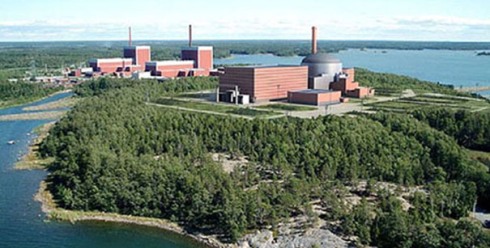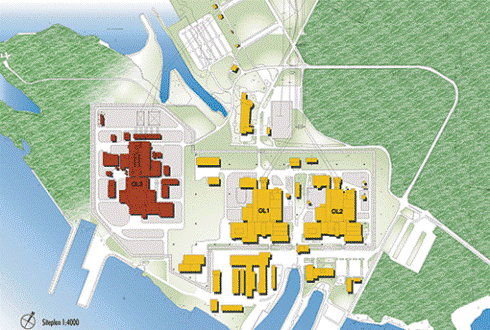Nuclear power: the new generation
 |
| The new Finnish nuclear reactor at Olkiluoto (OLK3) |
Nuclear power may or may not be an unfortunate necessity. But a look at Finland should temper any optimism about construction costs.
The government’s decision in early January 2007 to support (or, more precisely, not oppose) the construction of nuclear power plants in the UK prompted strongly felt responses from all sides. To the electricity generating industry, nuclear power represents an attractive way of reducing emissions. To most – but by no means all – environmentalists, the push for more nuclear power is both a mistake and a missed opportunity: a mistake because no country has yet shown that nuclear waste can be stored effectively, and a missed opportunity because nuclear baseload generation reduces the incentive to develop wind and tidal power.
This article looks at what we can learn from the building of the nuclear power station at Olkiluoto (OLK3) on the western coast of Finland. The ground works started here in early 2004 and the plant is now due to open in 2011. Does this project give us confidence that nuclear power stations can be constructed at a reasonable cost and to a reliable timescale?
***
OLK3 is Europe’s first new nuclear reactor for over a decade. The UK’s Sizewell B plant was commissioned in 1995 and since then most nuclear construction has been in Asia.
There are four existing nuclear reactors in Finland, operating on two sites. These reactors generate about 25% of Finland’s electricity. The OLK3 project is located at an existing nuclear site and will provide a further 15% of total national power needs.
After regulatory inquiries lasting many years, construction was approved in 2001 and the preparatory site works started in February 2004. The contract with the French nuclear company Areva is a fixed-price arrangement that sees the Finnish owner paying about €3bn for the 1,600 MW plant.
The site was handed over to Areva in February 2005 with the expectation that the plant would be completed in the middle of 2009. Areva had quoted a construction time of 54 months, or four and a half years, from when it first controlled the site. At the moment of handover, construction appears to have been on schedule.
Since February 2005, there have been five separate announcements from TVO, the plant’s eventual owners, giving details of the delays on the project.
OLK3 owner’s expectations of completion date
| Delay announcement | Date of announcement | Expected completion date | Implied construction period |
|---|---|---|---|
| Handover | February 2005 | First half of 2009 | 53 months* |
| 1 | January 2006 | Second half of 2009 | 59 months |
| 2 | July 2006 | Second quarter of 2010 | 65 months |
| 3 | December 2006 | Last quarter of 2010 | 71 months |
| 4 | August 2007 | '2011' | More than 71 months |
| 5 | December 2007 | Summer 2011 (assumed to be August 2011) | 79 months |
This table shows that in the 34 months since the Areva portion of the project began, the completion date has retreated by 26 months. Put another way, a 53-4 month project still has 44 months to run after it has been going for almost three years.
The reasons for the delays Close reading of the press releases of Areva and TVO, and media comment, suggests a list of substantial problems with the project:
- Finnish and foreign subcontractors have been unable to maintain the quality of their work. Few European countries have recent experience of the requirements of nuclear engineering and the construction expertise simply isn’t available.
- Some of the early concrete pouring was done at a time of year when it was likely to absorb too much moisture. This error was eventually noted by inspectors, who required a replacement of large amounts of concrete because of its high water content.
- The Finnish safety inspectorate has been more rigorous than Areva expected.
- Some of the huge metal castings have not been made to the quality and tolerances expected.
- The detailed engineering drawings for the project have been slower to produce than Areva hoped.
Until August 2007, TVO seems broadly to have accepted that Areva was doing its best. But in its press release of that month, TVO shows its first signs of irritation with the French company, suggesting that Areva had taken too long to tell it of the further delays it was experiencing.
 |
| Plan of the new Finnish nuclear reactor at Olkiluoto (OLK3) |
The Finnish reactor is a prototype. It is the first of its kind that has been built, though it is a refinement of a previous design. Some of the delays do appear to be an almost inevitable result of the lack of experience of the company and its subcontractors. The less than adequate manufacturing of components and the problems with concrete may be a result also of inexperience. The French also appear to have been surprised by the problems of obtaining full engineering drawings and getting approval from safety inspectors.
It is still early days on this, Finland’s biggest construction project, but there is no public evidence so far of any fundamental engineering problems. Although construction has been severely delayed and overruns have been substantial, there is no basis for concluding that Areva cannot construct a safe and well-functioning reactor here.
The financial consequences of the delays The full cost of the project was initially projected a €3bn, although some of this was to be borne by TVO. Because it is a fixed-price contract, Areva has borne a large fraction of the cost of overruns. Examination of Areva’s accounts and press reports suggests that the company made provisions for extra costs of about €750m in 2006 and probably a similar amount in 2007. So the total cost may currently be standing at more than €4.5bn.
There is conflicting evidence on whether Areva is having to increase the resources on the project to get it completed by 2011. In early documents, the company referred to employing a total of about 2,000 people on the site at the period of peak construction (which is probably this year). The number present in late 2007 was actually already 2,600, and only about one third of the labour force appears to have been Finnish, suggesting a need to import skilled workers from abroad. Other documents suggest large numbers of employees came from Poland, France, and Germany. As the project has progressed, the percentage of foreign workers on site has gradually increased.
The construction is financed by highly subsidised debt provided by a German bank as an export credit funded by the French state. (This arrangement is under EU investigation since export credits are usually only granted for sales outside the Union.) The interest rate – of less than 3% – is far lower than would have been granted if the banking had been done on commercial terms. The rate of bank interest matters greatly on long construction projects. If Areva is paid by TVO on completion of the power station, and the proper interest rate is, for example, 7%, then a year’s delay might add as much as 7% to the cost of the project. OLK3 is already three years late.
Add the various extra costs together, and the total bill for OLK3 will probably eventually exceed €5bn or even €6bn. If it had been financed on commercial terms, the cost would have been even greater. An overrun of this size is by no means unusual in nuclear construction (see Greenpeace’s analyis: ‘The Economics of Nuclear Power’ [accessed 14 January 2008]). At this price, the capital cost will exceed €3m per MW of capacity and may rise as high as €5m.
The implications for any UK nuclear power programme The Finnish power station may or may not be representative of problems likely to be experienced in the UK. In the last few months, Areva has begun construction of a second power station at an existing nuclear site in Normandy. The projected cost is €3.3bn and the construction time is estimated at 60 months or less. In other words, Areva is sticking with the numbers it produced when it won the Finnish contract and not suggesting that the actual experience there is likely to be a better estimate of the real cost.
But whether Areva now feels it has learnt the lessons from OLK3 or whether it is simply being excessively optimistic, the UK represents an entirely new challenge. Construction costs tend to be high and overruns are almost inevitable. Labour productivity levels are low, and project management skills are woefully lacking. It would seem prudent for Areva to offer a price in the UK that is at least 20%, and possibly 50%, above the levels it charges in the rest of Europe.
Areva reports that it has had enquiries from eleven utilities interested in having the company build a reactor in the UK. The company expects to build four or six nuclear power stations in the UK. Would they make financial sense? If Areva does achieve a cost of €3.3bn in France and a construction time of less than 5 years, nuclear energy probably costs less than 2p per kilowatt hour. This beats any alternative technology. Onshore wind is certainly more expensive. But if the true cost is actually double or triple this figure (which it most certainly would be if the Finnish experience is the right guide and we added a premium for the UK) then both onshore and just possibly offshore wind look better in strictly financial terms. A decision by a utility to press ahead with Areva’s nuclear design (which is by far the most likely to be adopted in the UK) is, quite simply, a financial gamble on whether Areva’s Normandy cost projections are correct, or whether the actual UK figure will be the Finnish cost inflated by a UK premium and the commercial cost of capital.
This is before considering the unresolved question of how we store radioactive waste.